Turbosound TA-880 User Manual
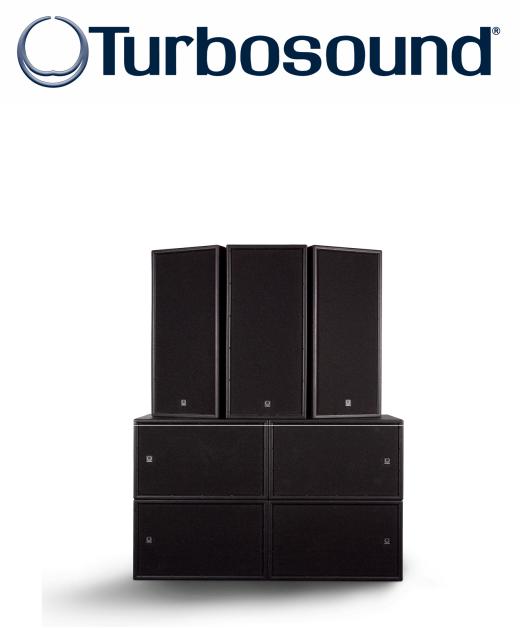
ASPECT TA-880 SYSTEM
USER MANUAL
Turbosound Ltd.
Star Road, Partridge Green
West Sussex RH13 8RY England
Tel: +44 (0)1403 711447 Fax: +44 (0)1403 710155
web: www.turbosound.com
Issue 1.5 © Turbosound Ltd, January 2006

user manual
TA-880
Contents |
|
EC Declaration of Conformity........................................................................................................................ |
6 |
Introduction .................................................................................................................................................... |
7 |
Turbosound Aspect System Concepts ..................................................................................................... |
7 |
The Aspect Polyhorn™ Concept............................................................................................................... |
8 |
Aspect TA-880 Turnkey System Concept................................................................................................. |
9 |
The Loudspeaker Management System (LMS) Concept....................................................................... |
10 |
LMS-D26/D6 Loudspeaker Management Systems ................................................................................ |
10 |
Amplifier Racks........................................................................................................................................ |
10 |
Power Amplifiers..................................................................................................................................... |
11 |
Digital Controllers ................................................................................................................................... |
11 |
Aspect Loudspeaker Components.......................................................................................................... |
11 |
TA-880L Low Frequency Enclosure ........................................................................................................ |
12 |
TSW-218 Subwoofer ............................................................................................................................... |
12 |
TA-880H Mid/High Enclosure.................................................................................................................. |
12 |
TA-880HM High-Mid Enclosure .............................................................................................................. |
13 |
TA-880LM Low-Mid Enclosure................................................................................................................ |
13 |
Transportation ......................................................................................................................................... |
14 |
Aspect trapezoidal Flying System .......................................................................................................... |
15 |
Flying and Stacking...................................................................................................................................... |
16 |
Overview.................................................................................................................................................. |
16 |
GigMate™ Acoustic Simulation .................................................................................................................. |
17 |
Running Turbosound GigMate / EASE Focus for the first time:........................................................... |
17 |
System Setup .......................................................................................................................................... |
18 |
Mapping Properties................................................................................................................................. |
18 |
Audience Area ......................................................................................................................................... |
18 |
Rigging..................................................................................................................................................... |
18 |
Designing a system ................................................................................................................................. |
19 |
Safety Notes on Rigging ......................................................................................................................... |
23 |
Flying Hardware ........................................................................................................................................... |
25 |
TA-880 user manual Page 2

|
user manual |
|
TA-880 |
Horizontal Coverage................................................................................................................................ |
25 |
Vertical Coverage .................................................................................................................................... |
26 |
Wide and Narrow Flybar settings........................................................................................................... |
26 |
Two-wide trapezoidal flybar FB-880/2W ................................................................................................ |
27 |
Three-wide trapezoidal flybar FB-880/3W.............................................................................................. |
28 |
Flying Chains ........................................................................................................................................... |
29 |
Flying Swords.......................................................................................................................................... |
30 |
Tilting Strap ............................................................................................................................................. |
31 |
Flying a single TA-880 trapezoidal cabinet using M10 eyebolts........................................................... |
32 |
Flying a single TA-880 trapezoidal cabinet using FC-880 chains.......................................................... |
33 |
Flying a vertical column of TA-880 trapezoidal cabinets ...................................................................... |
34 |
Flying a cluster of TA-880 trapezoidal cabinets..................................................................................... |
37 |
Single horizontal row.............................................................................................................................. |
37 |
2 wide x 2 deep TA-880H array............................................................................................................... |
38 |
3 wide x 3 deep TA-880H array............................................................................................................... |
39 |
Tight-packed Flying Assemblies............................................................................................................. |
40 |
Bass Enclosure arraying.......................................................................................................................... |
42 |
Aiming - directivity of the stack.............................................................................................................. |
42 |
Ground stacking ...................................................................................................................................... |
43 |
LMS series Loudspeaker Management Systems ....................................................................................... |
44 |
Introduction ............................................................................................................................................. |
44 |
Unpacking................................................................................................................................................ |
44 |
Mechanical Installation ........................................................................................................................... |
44 |
LMS-D6 Loudspeaker Management System .............................................................................................. |
45 |
LMS-D6 Rear Panel Functions ................................................................................................................ |
46 |
Mains Power............................................................................................................................................ |
46 |
Voltage Settings ...................................................................................................................................... |
47 |
Safety Earthing........................................................................................................................................ |
47 |
AC Power Fusing ..................................................................................................................................... |
47 |
Powering Up............................................................................................................................................ |
47 |
Audio Connections.................................................................................................................................. |
48 |
Input and Output Connector Wiring....................................................................................................... |
48 |
Time correction for loudspeaker driver placement ............................................................................... |
48 |
LMS-D24 and D26 Loudspeaker management Systems............................................................................ |
49 |
TA-880 user manual Page 3

user manual
TA-880
Features ................................................................................................................................................... |
49 |
Front Panel Functions ............................................................................................................................. |
50 |
Rear Panel Functions............................................................................................................................... |
52 |
Operating the LMS-D24 and D26............................................................................................................ |
53 |
Starting up ............................................................................................................................................... |
53 |
Selecting a Factory Preset....................................................................................................................... |
53 |
Creating a Crossover............................................................................................................................... |
53 |
Navigation and Viewing Parameters...................................................................................................... |
54 |
Navigation................................................................................................................................................ |
55 |
Presets...................................................................................................................................................... |
56 |
Preset Recall ............................................................................................................................................ |
56 |
Preset Store ............................................................................................................................................. |
57 |
DSP Processing Layout ........................................................................................................................... |
58 |
Input DSP block diagram ........................................................................................................................ |
58 |
Output DSP block diagram ..................................................................................................................... |
58 |
Stereo / Mono Formats ........................................................................................................................... |
58 |
DSP processing........................................................................................................................................ |
59 |
Input Channels......................................................................................................................................... |
59 |
Parametric Equalisation .......................................................................................................................... |
61 |
High and Low shelving filters ................................................................................................................. |
61 |
Parametric filters ..................................................................................................................................... |
61 |
Output Channels...................................................................................................................................... |
62 |
Gain and Polarity..................................................................................................................................... |
62 |
Delay ........................................................................................................................................................ |
62 |
High and Low Pass Filters....................................................................................................................... |
63 |
Parametric Equalisation .......................................................................................................................... |
64 |
Limiters .................................................................................................................................................... |
65 |
Routing..................................................................................................................................................... |
65 |
Utilities..................................................................................................................................................... |
66 |
Utility functions ....................................................................................................................................... |
66 |
Rear Panel Functions............................................................................................................................... |
67 |
AMP-890 Aspect System Amplification Rack......................................................................................... |
68 |
Racking, Cables and Connections........................................................................................................... |
68 |
Options..................................................................................................................................................... |
69 |
Input Connections ................................................................................................................................... |
69 |
Figure 1. Amplifier Rack Signal Wiring.................................................................................................. |
70 |
Output Connections ................................................................................................................................ |
70 |
Figure 2. Mid-High Outputs .................................................................................................................... |
71 |
Figure 3. Bass Outputs ............................................................................................................................ |
71 |
Break-out Cables – NL4 bass................................................................................................................... |
72 |
Break-out cables – NL8 mid-high............................................................................................................ |
73 |
Extension Cables ..................................................................................................................................... |
73 |
Mains Connections.................................................................................................................................. |
74 |
T-25 and T-45 High Efficiency Audio Power Amplifiers............................................................................. |
75 |
TA-880 user manual Page 4

|
user manual |
|
TA-880 |
General Features & Facilities.................................................................................................................. |
75 |
Front Panel Functions T-25 ..................................................................................................................... |
76 |
Front Panel Functions T-45 ..................................................................................................................... |
77 |
Mechanical Installation ........................................................................................................................... |
78 |
Mains Power............................................................................................................................................ |
78 |
Powering Up............................................................................................................................................ |
78 |
Safety Earthing........................................................................................................................................ |
78 |
Voltage Setting........................................................................................................................................ |
79 |
Voltage Range ......................................................................................................................................... |
79 |
Audio Connections & Controls ............................................................................................................... |
79 |
Polarity..................................................................................................................................................... |
80 |
Input Impedance...................................................................................................................................... |
80 |
Gain and Sensitivity Settings ................................................................................................................. |
80 |
Attenuation & Gain Setting .................................................................................................................... |
81 |
Output Connections ................................................................................................................................ |
81 |
Damping Factor ....................................................................................................................................... |
81 |
Long Speaker Lines ................................................................................................................................. |
82 |
The Cooling System ................................................................................................................................ |
82 |
Appendix A: Technical Specifications......................................................................................................... |
83 |
Appendix B: Warranty.................................................................................................................................. |
85 |
TA-880 user manual Page 5

user manual
TA-880
EC DECLARATION OF CONFORMITY
Manufacturer
Turbosound Ltd
Star Road, Partridge Green, West Sussex, RH13 8RY
Products
T-25 Power Amplifier
T-45 Power Amplifier
LMS-D6 Controller
LMS-D26 Controller
LMS-D24 Controller
Standards |
|
Safety |
EN60065:2003 |
Relevant Specifications used as basis for tests |
EN66103-1:1996 |
|
EN55103-2:1996 |
Category
Professional apparatus for use in Commercial Light Industrial and controlled EMC environments.
CE Marking
All products are marked in accordance with the relevant statutory requirements.
TA-880 user manual Page 6
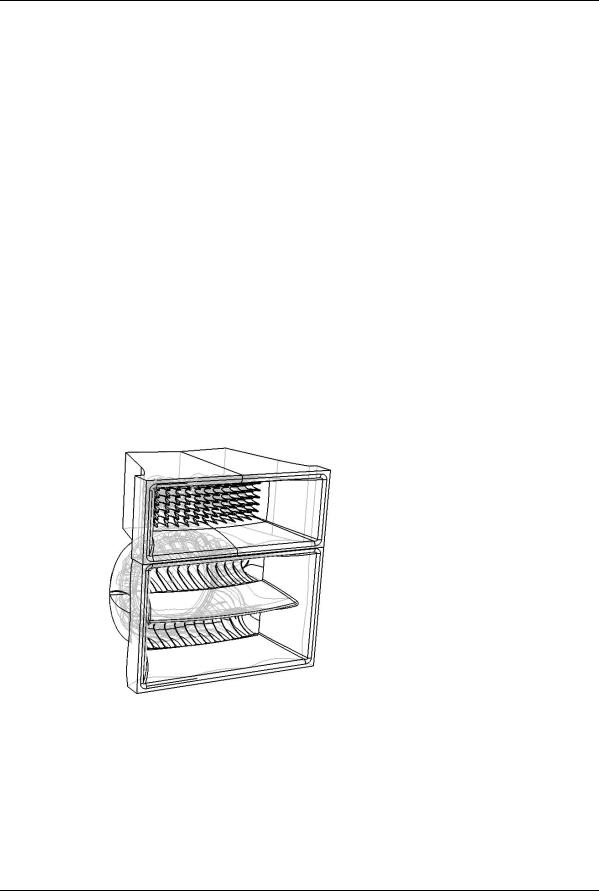
user manual
TA-880
INTRODUCTION
Turbosound Aspect System Concepts
The TA-880 system is a modular point source loudspeaker system designed to deliver extremely high fidelity audio. The system is easily scaleable from large and medium scale ground-stacked and flown concert touring down to small clubs and events.
The Aspect system concept centres around the exceptional directivity of the patented Polyhorn™ devices employed in the high frequency and high-mid frequency sections of the mid/high enclosure. In contrast to the majority of conventional horns, Polyhorns develop more consistent frequency response across all seats of an auditorium with minimal interference between adjacent enclosures.
The patented Polyhorn™ devices – employed in both the high frequency and high-mid frequency bands – exhibit a sharp cut-off at the edges of the dispersion pattern, making it possible to produce seamless coverage of a venue with minimal destructive interference between elements, however many individual enclosures are deployed in the cluster. The Polyhorn™ devices generate phase-coherent and smoothly-curved wavefronts which match the array curvature, whose centre becomes the virtual point source.
The TA-880H trapezoidal mid/high enclosure forms the main component of ground-stacked or flown arrays. It can also be employed as a front or side fill cabinet. The TA-880HM highmid enclosure and TA-880LM low-mid enclosure are available for use in specific fill applications to cover near-field audience areas such as downfills or front-of-stage fills. The TA-880L low frequency enclosure is designed to be ground stacked in bass arrays as well as providing ground support for TA-880 enclosures.
TA-880 user manual Page 7

user manual
TA-880
The Aspect Polyhorn™ Concept
The patented Polyhorn™ design effectively solves the problem of the tendency for exponential horns to beam with increasing frequency. Dividing the multi-cellular horn into multiple tapered waveguides guarantees that the path length of each micro-horn is equal from the surface of the driver diaphragm to the horn mouth, and ensures that all frequencies from all parts of the diaphragm arrive at the horn mouth together. This provides the wavefront with uniformity of phase. A further benefit of the Polyhorn™ geometry is that the sound wave does not suffer from edge-diffraction effects which have a tendency to confuse the directionality of the sound source.
Each cabinet in an array of Aspect loudspeakers contribute to the generation of a single, cohesive, and more or less continuous wavefront without noticeable comb-filtering effects. In addition, the Polyhorn™ design offers the possibility of locating the acoustic centre well behind the motor system and even the enclosure. The wavefront radii can now be arranged to coincide with the array curvature, forming a single virtual point source.
Because of the Polyhorn™ design’s sharp cut-off, its array angle can in practice be taken as being the same as the dispersion angle.
Fig 1. Conventional HF horns produce destructive interference
Fig 2. Poyhorn™ creates smoothly curved and phase-coherent wavefront
TA-880 user manual Page 8

user manual
TA-880
Aspect TA-880 Turnkey System Concept
Aspect is available as an integrated audio system package, comprising loudspeakers with integral flying hardware, amplifier racks and all necessary drive and control equipment in an extremely compact and manageable form. In addition, the system has been designed to truck pack efficiently and handle easily.
The concept of assembling a system around standardised components ensures absolute compatibility between users, although sufficient flexibility is built into the rack design to allow for varying requirements such as the ratio of bass cabinets to mid-highs, or 4-way or 5- way operation. Aspect systems from different sources may therefore be freely combined without difficulty. This provides owners with a considerable competitive advantage in servicing the requirements of international touring productions, and in co-operating with other Aspect suppliers within the worldwide network.
The system controller functions as an electronic loudspeaker management system, comprising a 24dB per octave crossover, with factory preset limiters matched to the power amplifiers, digital time-alignment and electronically balanced inputs and outputs.
The standard trapezoidal Aspect integrated sound system consists of:
•TA-880H mid-high enclosures and TA-880L enclosures
•Flybars, flying chains and flybar trunk
•Loudspeaker break-outs and multi-way extensions
•Multi-way returns system
•LMS-D6 or LMS-D26 system controllers
•AMP-890 ampifier racks with:
•T-45 and T-25 power amplifiers
•Three phase 32A power distribution
•Multi-way and local speaker connections
TA-880 user manual Page 9

user manual
TA-880
The Loudspeaker Management System (LMS) Concept
Turbosound Loudspeaker Management Systems are more than just electronic crossovers. As well as steep slope active filters and high performance limiters, they provide full digital alignment of all components in the Aspect enclosures, to ensure a coherent acoustic output. They also incorporates a number of features which contribute to overall system reliability and ease of setting-up and use.
All system parameters such as crossover frequencies, limiter settings and equalisation can be simply called up from a factory-set menu, making it possible to maintain consistent and repeatable system performance.
Because the power amplifiers can be included as part of the Aspect system, the controllers are able to utilise output limiters which are precisely matched to the system requirements, being pre-set to prevent the amplifiers from clipping. Inputs and outputs are fully balanced, providing isolation between the controller and the amplifier inputs. These factors contribute to high reliability in the adverse circumstances often encountered under arduous touring conditions.
LMS-D26/D6 Loudspeaker Management Systems
Use of the LMS-D26 or LMS-D6 loudspeaker management system ensures accurate timealignment of the system drive units and also provides a facility for users to select additional delay, either to compensate for physical displacement of ground-stacked bass enclosures relative to flown high packs, or to provide full range delay for correct image localisation or use in distributed systems. It should however be noted that the high-Q, and therefore long throw, properties of the Aspect system generally eliminates the need for distributed delayed systems, even for very large audiences.
Amplifier Racks
The Aspect amplifier racks are fully loaded and fully equipped for the most demanding concert touring applications. They are fitted as standard with two T-25 model amplifiers and three T-45 model amplifiers, Socapex speaker break-outs as well as local connectors, singlephase or three-phase mains distribution, and multi-way signal input and signal link connectors. All the component parts are rigidly mounted in a 12U steel space frame with removeable panels, and housed in a road case with heavy duty wheels.
TA-880 user manual Page 10

user manual
TA-880
Power Amplifiers
In addition to the Turbosound T-25 and T-45 model amplifiers supplied with turnkey Aspect systems, the following other power amplifier brands provide sufficient performance and mechanical compatibility to perform well with Aspect loudspeaker systems:
•MC2 E series
•Lab Gruppen FP series
•Crest Pro series
•QSC Powerlight II series
Digital Controllers
In addition to the Turbosound LMS-D6 and LMS-D26 loudspeaker management systems, the following digital crossovers have been tested and are recommended for use with Aspect systems:
•BSS FDS366
•XTA 224. 226 and 428
Aspect Loudspeaker Components
All the drive units have been designed in-house specifically for the Aspect system and are manufactured exclusively for Turbosound. This means that they are expressly suited to their intended purpose, and make use of innovative features to ensure premium performance.
Neodymium magnets are used throughout all drive units. This results in higher efficiency, less power compression and reduced overall weight.
Low-mid frequency drivers are designed to be rear-facing in the enclosure, enabling the heatsink / phase plug to be placed in the air flow to aid cooling.
TA-880 user manual Page 11

user manual
TA-880
TA-880L Low Frequency Enclosure
The TA-880L low frequency enclosure covers the low frequency range from 40Hz up to 100Hz. It contains two very high power 15" neodymium drive units loaded with TurboBass™ devices. The TA-880L is a very compact enclosure and its minimal size and low weight ensures easy handling. It is designed to provide beneficial low frequency coupling when used in multiples. The enclosure is designed to be groundstacked.
TSW-218 Subwoofer
The TSW-218 is designed to cover the sub and low frequency ranges from 25Hz to 160Hz, and can be used as part of a 5-way Aspect system in order to reinforce sub-bass frequencies. It utilises two custom designed neodymium 18” drivers loaded with TurboBass devices. The proprietary loading technique and horn flare design produces significant mutual coupling between adjeacent enclosures, resulting in sensitivity gains of up to 110dB with eight units coupled.
TA-880H Mid/High Enclosure
The TA-880H enclosure covers frequencies above 100Hz and contains a total of five drive units. A pair of 10” neodymium low-mid frequency drivers loaded with TurboMid™ devices covers the frequency range from 100Hz to 400Hz. The low-mid drivers are rear-facing in the enclosure, providing not only additional cooling by placing the magnet/heatsink assemblies in the path of the airflow, but also acting as phase plugs. A specially developed 10” low-mid driver loaded with a LMF Polyhorn™ device covers the range from 400Hz to 4kHz. The remaining frequencies are covered by a pair of 50mm dome drivers loaded with Polyhorn™ waveguides specifically designed for this purpose.
The TA-880H Mid-High Enclosure is designed to provide a precise array angle of 25º horizontal x 15º vertical. This high Q provides the projection necessary for true long throw applications such as large arena and outdoor productions.
TA-880 user manual
Page 12
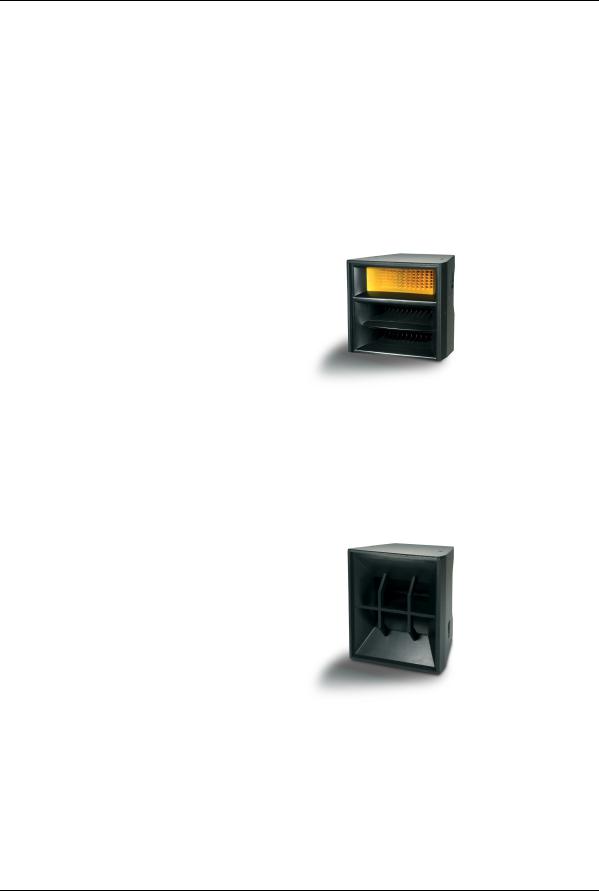
user manual
TA-880
The Polyhorn™ and TurboMid™ devices are unique to Turbosound and are covered by principle patents world-wide. They utilise specialised forms of horn loading which provide exceptionally low distortion and high efficiency from cone-type drive units. The subjective effect of these devices is greater clarity and transparency of reproduction when compared with conventional compression drivers and horns.
The TA-880H can be equipped for touring applications with an external flying system consisting of removeable swords and fixed angle flybars.
TA-880HM High-Mid Enclosure
The TA-880HM enclosure contains high frequency and high/mid frequency elements only and is designed is to be used as a downfill or in-fill enclosure, either flown or ground-stacked. It covers the frequency range from 405Hz to 20kHz, and provides a coverage pattern of 25°H x 15°V.
The TA-880 external flying system of removeable swords allows all types of TA-880 enclosures to be combined freely in flown clusters.
TA-880LM Low-Mid Enclosure
The TA-880LM enclosure is a low-mid frequency only enclosure and is designed is to be used as a downfill or in-fill enclosure, either flown or groundstacked. It covers the frequency range from 100Hz to 405Hz.
As with the TA-880HM above, it can be combined into TA-880 clusters using removeable swords.
TA-880 user manual Page 13

user manual
TA-880
Transportation
An optional WB-880H wheelboard is available which clips on to the front of the TA-880H cabinet, allowing single units to be conveniently transported. These are designed to be stackable, so that when not in use they can be neatly stored without taking up unecessary floor space.
TA-880L bass cabinets are fitted with heavy duty wheels.
Optional heavy duty transit covers are available for TA-880H cabinets. These simply slide over the box and fasten underneath the cabinet with velcro straps.
TA-880 user manual
Page 14
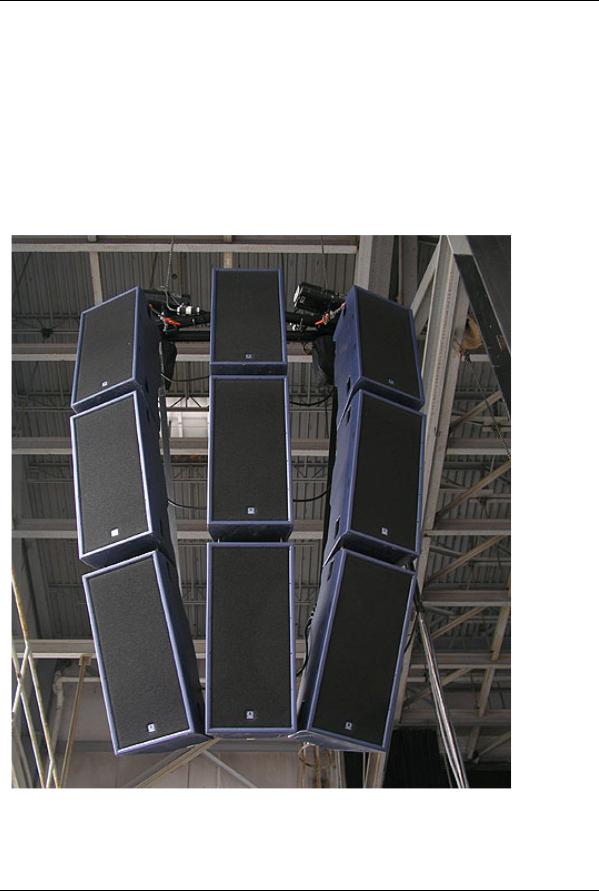
user manual
TA-880
Aspect trapezoidal Flying System
To take full advantage of the very precise dispersion properties of the Aspect system, an external rigging system has been developed. The flying systems are inherently safe, flexible and simple to use. The rigging design allows the creation of clusters and arrays that can be assembled quickly and with a minimum number of crew, and with full control of the vertical angles between enclosures and their vertical inclination, to suit a wide variety of requirements.
TA-880 user manual Page 15
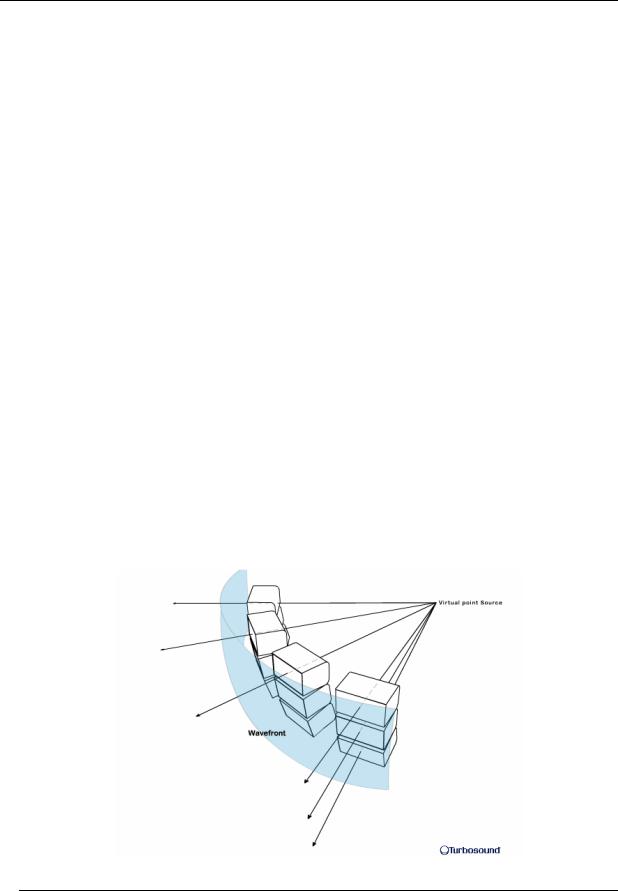
user manual
TA-880
FLYING AND STACKING
Overview
The Aspect system flying hardware is specifically designed to take advantage of the precise horizontal directivity characteristics, as well as allow a wide range of adjustment of the vertical angles between adjacent enclosures, and the overall vertical inclination of each column of enclosures. This means that arrays can easily be optimised to suit the coverage requirements of any situation.
Sound radiating from adjacent cabinets will successfully blend over a range of included angles, creating a coherent point-source image, and this results in the ability to tailor both the overall coverage and the SPL at a given distance.
The concept of arraying a point-source loudspeaker system is to create part of the surface of a sphere. A small part of a large sphere will form a high-directivity (long-throw) system with a high SPL at a distance, whereas a large part of a small sphere will be of lower directivity producing less SPL at a distance, but having a wider angle of coverage. This approach leads to the creation of a virtual point source of sound behind the array.
There are some simple rules to follow to help achieve this goal:
•Obtain a smooth even curve in the horizontal plane.
•Use a similar amount of tilt on each column.
•Ensure that the bottom corners of each column are in line with each other.
TA-880 user manual Page 16
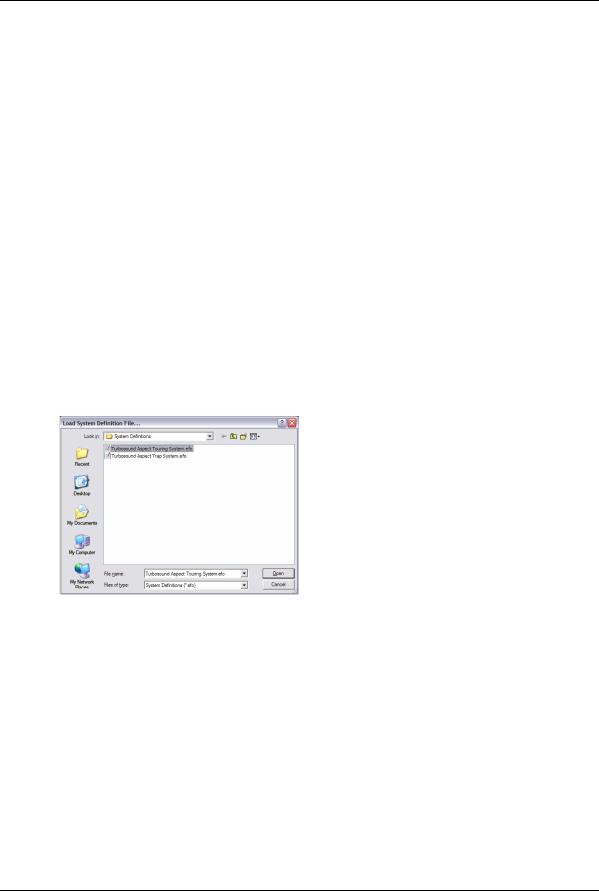
user manual
TA-880
GIGMATE™ ACOUSTIC SIMULATION
While the Aspect System is remarkably intuitive in terms of building arrays and aiming them, and requires no theoretical calculations in order to achieve optimum coverage of a room or audience space due to its inherent ‘point-and-shoot’ nature, there may well be situations where some prior knowledge of a venue can save time in setting up and configuring the PA. In order to aid in this process, Turbosound offers the GigMate™ software acoustic simulation package, a version of the generic EASE Focus program that is based on current EASE 4.1 data.
GigMate™ provides an accurate elevation representation of sound pressure level and coverage of a room, given the dimensions of the audience areas and location of available rigging points in the venue. The database allows for flown clusters of TA-890 touring or TA880 trapezoidal enclosures, or for ground stacked arrays.
Running Turbosound GigMate / EASE Focus for the first time:
When you first start the program you must set the system file that it is to use. The installation files include two Turbosound Aspect System files as shown below:
Select the Trapezoidal version of Aspect.
You will now be presented with the GigMate main screen.
TA-880 user manual Page 17
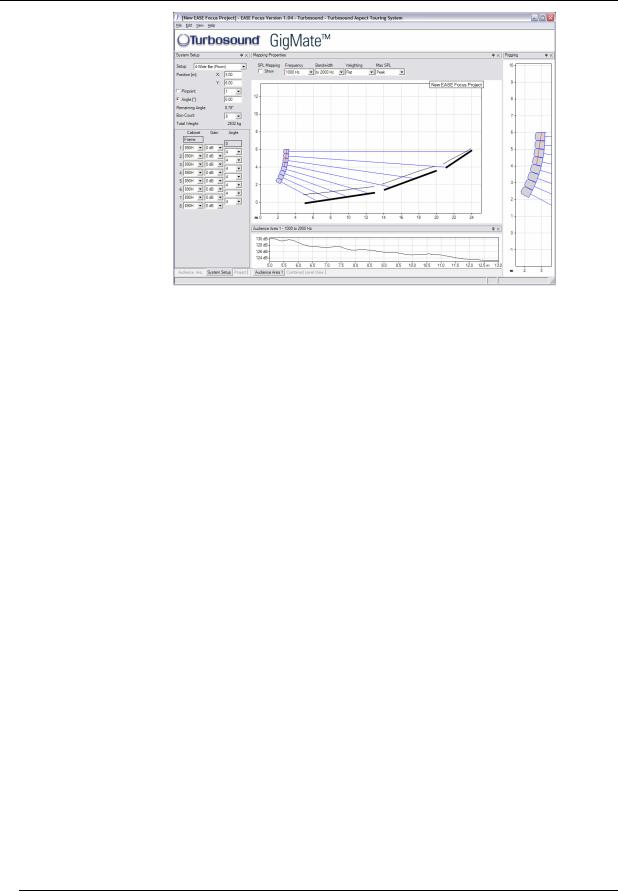
user manual
TA-880
The screen is split into four main areas:
System Setup
The left hand side of the screen is where you define the system, auditorium and project. Tabs On the bottom of this window allow you to toggle between modes.
Mapping Properties
This is the main window which will display the system as configured in the System Setup window along with the audience areas and mappings.
Audience Area
Beneath the main Mapping Properties window this graphically displays the SPL on each audience area, or across a combination of audience areas.
Rigging
The far right window shows the detail of the system configuration and is especially useful in larger venues where the speakers shown in the main window become very small.
TA-880 user manual Page 18
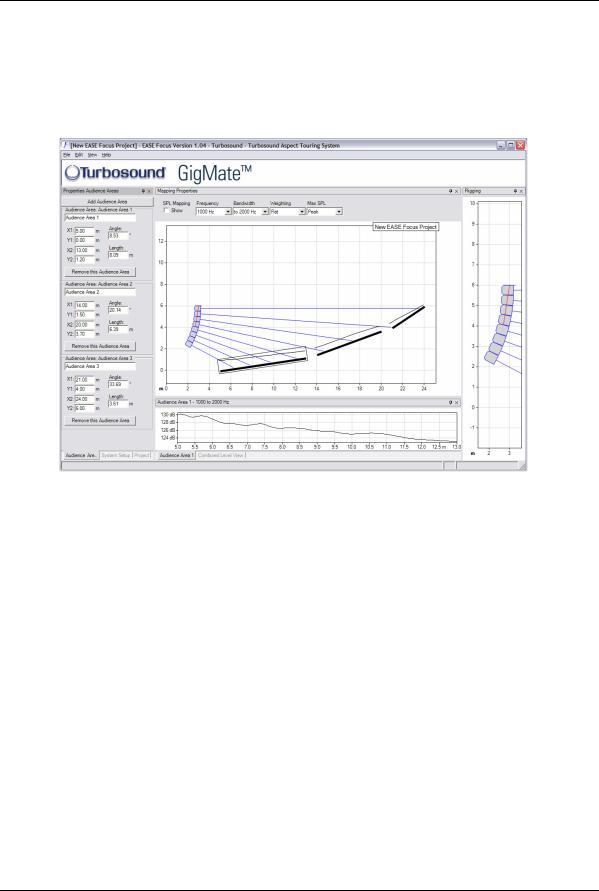
user manual
TA-880
Designing a system
To design a system begin by defining the venue/audience areas by clicking on the “Audience Area” tab in the bottom left of the screen.
Within this window you can edit or remove existing audience areas, and create new ones.
There are two methods of defining an audience area. In either case you must define the X1/Y1 coordinate of the start of the area, you can then either enter the X2/Y2 points or its length and angle.
As you create audience areas they are show graphically in the main window.
The next step is to design the loudspeaker array using the System Setup window. Select the System Setup tab in the bottom left of the screen and begin by choosing the desired flybar or groundstack in the drop down box at the top left of the window.
TA-880 user manual Page 19
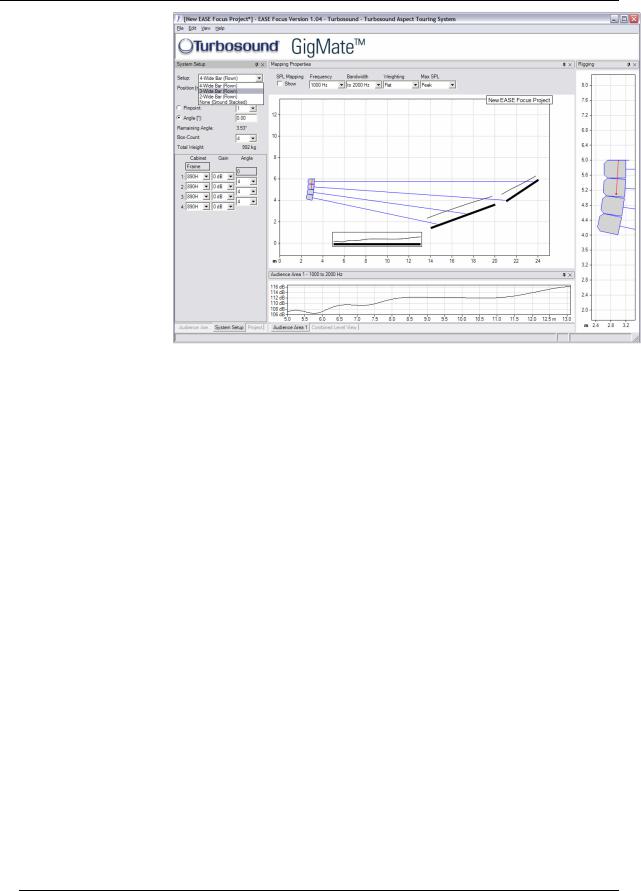
user manual
TA-880
Now select the number of cabinets deep that you wish to hang or stack in the “Box Count” dropdown. Trim height, or PA wing height can now be set in the “Position” field.
If a mix of Low and High cabinets are to be used then select in the Cabinet window the type and location in the array of each box. The angle between cabinets can now be set in the “Angle” list. Each cabinet has an aiming line that can be used to determine the centre of each cabinet’s dispersion. Adjust the trim height, top angle and intercabinet angle to achieve optimum coverage.
TA-880 user manual Page 20
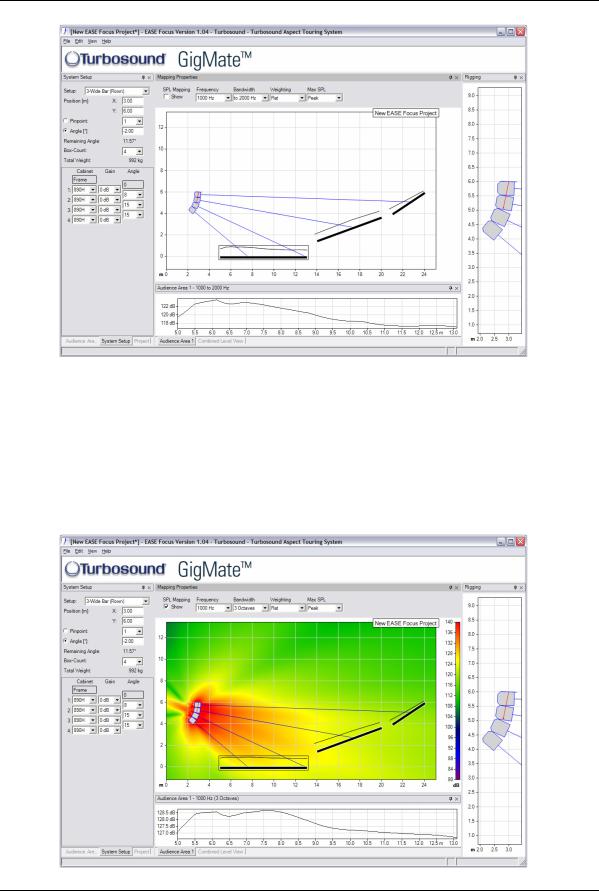
user manual
TA-880
Now that the general design has been established the system performance must be mapped. At the top of the main window there is an “SPL Mapping” checkbox. This will map the system output at the frequency and bandwidth selected in the adjacent dropdown boxes. For most applications a 3 octave mapping gives realistic and useful data.
TA-880 user manual Page 21

user manual
TA-880
The Audience Area graph at the bottom of the window shows the SPL, as specified in the SPL Mapping lists, on the selected Audience Area. The selected area is highlighted in the main window and the graph is repeated onto op each area, Selecting the “Combined Level View” tab will show the SPL across all areas simultaneously.
Now that the system is mapped the intercabinet angles or row attenuation may be trimmed to provide the smoothest coverage. Typically the bottom row of the system will require some attenuation and should be on it’s own “Amp way” to achieve this.
TA-880 user manual Page 22

user manual
TA-880
Safety Notes on Rigging
The Turbosound TA-880 system has been designed and constructed to a high standard of safety, and tested to the most demanding of specifications with a safety factor of 13:1. Always wear protective headwear, footwear and eye protection in accordance with local regulations. Anyone involved in flying ANY sound system, especially in a touring capacity, should take note of the following advice:
The rigging of a flown sound system may be dangerous unless undertaken by qualified personnel with the required experience and certification to perform the necessary tasks. Fixing of hanging points in a roof should always be carried out by a professional rigger and in accordance with the local rules of the venue. The house rigger and/or building manager must always be consulted.
You should observe particularly the following points:
Inspect rigging systems and cabinets for damage before proceeding to assemble a flown array. If any parts are damaged or suspect, DO NOT USE THEM.
When initially ratcheting a column of speakers it is good to bear in mind the expected angle of inclination so as to avoid ending up with too much of the strap left on the ratchet. This is important because the ratchet can only take three complete turns before it releases itself.
WARNING: If a tilt strap is released suddenly, the column of enclosures may tend to swing violently forwards and care must be taken to avoid danger to persons in the vicinity. It is essential to check that nobody is standing immediately in front of the column, and to give a suitable warning, before the strap is released. Ideally, two persons should support the column from the side whilst the strap is released, or alternatively the bottom row may be returned to the ground before release. In any event it is essential that all personnel in the vicinity are aware that the system is about to move and that they must keep clear.
Aspect Flying System components have been individually tested in accordance with the following regulations:
•The Health and Safety at Work Act 1974
•The Supply of Machinery (Safety) Regulations 1992
•The Lifting Operations and Lifting Equipment Regulations 1998
Each component is covered by a Record of Load Test Certificate, which may be obtained on request from Turbosound, quoting the indentifying number(s) from the flying equipment. A copy of a sample certificate is reproduced overleaf.
TA-880 user manual
Page 23
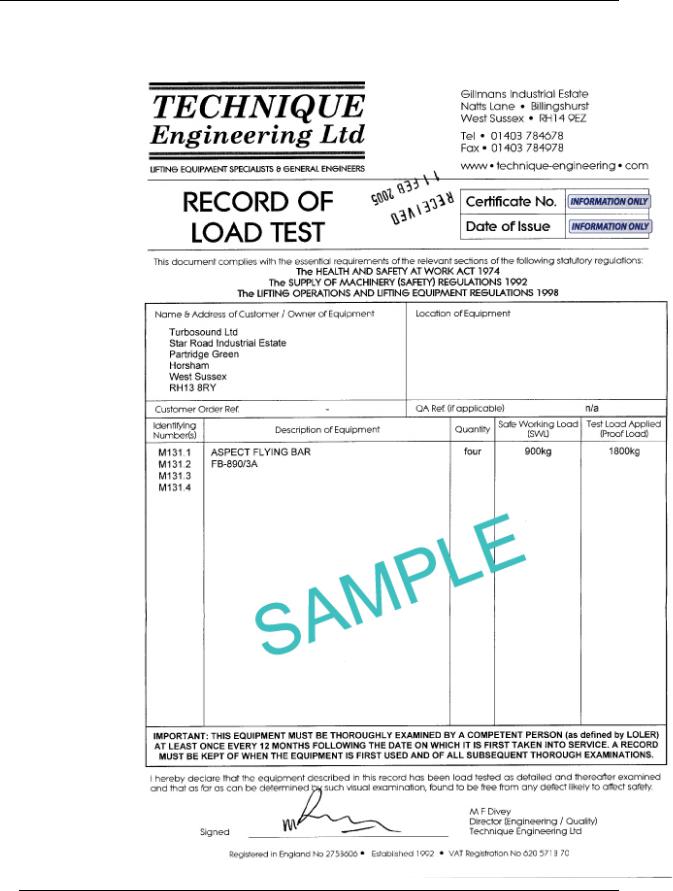
user manual
TA-880
Sample Certificate of Load Test
TA-880 user manual Page 24

user manual
TA-880
FLYING HARDWARE
The Aspect TA-880 flying system consists as follows:
•Flying swords and safety lynch-pins – support a single cabinet.
•Flying chains – link the top row to flybars.
•Twin bar – supports two vertical columns.
•Triple bar – supports three vertical columns
•Chain bridles for twin and triple bars
The flying system is based around the use of removeable flying swords which pass through slots machined in the enclosure and are held captive by safety linch-pins through holes in the swords, locating into load-rated metal fixings incorporated into the handle boxes. The flying system eliminates the need for costly integral flying hardware, thereby not penalising those users who exclusiv ely ground stack and therefore have no flying requirements.
Horizontal Coverage
Because the Polyhorn’s design dramatically reduces the acoustic energy outside of the specified 25° horizontal dispersion pattern, it is recommended that Aspect TA-880 enclosures always be arrayed in a smooth even curve, resulting in an array angle of 25° between boxes. Based on this assumption it is an easy job to assess how many columns, and therefore which particular combination of flybars, will be needed to achieve the required coverage. The top chains are adjustable to allow the cluster to hang either close to the bar where trim height is critical, or further away when more radical kelp is applied to the columns.
The following table illustrates how many columns of loudspeakers and which flybars should be used to achieve a given horizontal coverage.
Required Horizontal Coverage |
Number of Colums |
Flybar |
|
|
|
25° |
Single column |
N/A |
50° |
Two columns |
FB-880/2W |
75° |
Three columns |
FB-880/3W |
TA-880 user manual Page 25

user manual
TA-880
Vertical Coverage
Vertical coverage is dictated by the physical dimensions of the room and the location of the audience spaces. The number of boxes required in a vertical column is therefore determined by a number of factors including the trim height of the cluster, the vertical coverage you are trying to achieve, and the distance or projection required.
Wide and Narrow Flybar settings
The flybars are equipped with two choices of cabinet suspension tabs and tilt strap points for each column of loudspeakers. These are provided in order to accommodate different numbers of cabinets in a vertical column. The narrow setting is sufficient when flying columns up to two deep. However when flying three or four cabinets deep the wide setting - with its wider horizontal spacing - allows sufficient downward tilt before the backs of the lower boxes touch.
TA-880 user manual Page 26
